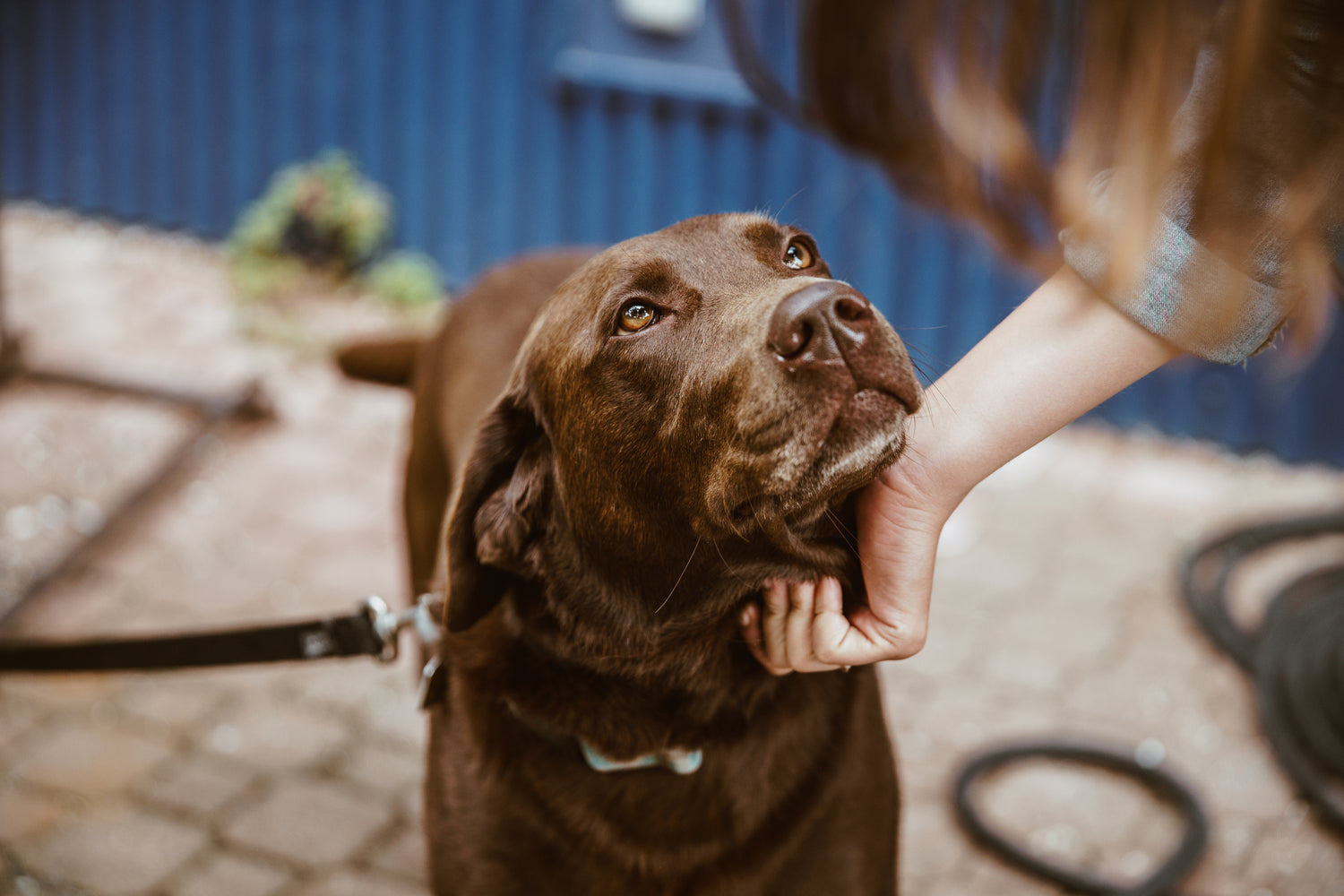It can feel overwhelming when you receive a diagnosis of hip dysplasia for your dog, there’s a lot of information to process and of course you want to make the best decision for your dog’s health now, and going forward.
Hip dysplasia in dogs is a common orthopaedic condition that affects many dogs. The hip joint is unstable and this can be caused by poor conformation of the hip bone (usually a hip socket that’s too shallow) or the ball of the thigh bone being misshapen. There can also be ligament laxity. The ‘ball and socket’ relationship of the hip joint and thigh bone doesn’t work well.
Normally the surfaces of two glide together well. With hip dysplasia they rub together uncomfortably which results in inflammation, possible microfracturing of the bone and degeneration of the hip cartilage, swelling, and eventually arthritis (i.e. accelerated wear and tear). All of this is painful for your dog.
Symptoms of hip dysplasia in dogs usually start while they’re growing
It’s often diagnosed when a dog’s still a puppy. Recognising the early signs of hip dysplasia means prompt intervention and improved quality of life for your dog. Onset of clinical signs vary but hip dysplasia in puppies is most commonly diagnosed between 6 and 12 months of age.
Symptoms can start from as young as four months of age. So, if you notice your puppy is displaying any of these signs, take them for a vet check-up.
Older dogs may develop it simultaneously with osteoarthritis as they get older.
Hip dysplasia symptoms vary, depending on its severity. Inflammation levels, joint laxity and the length of time your dog’s been suffering from it, will also affect how symptoms present themselves.
There are four levels of hip dysplasia:
- Early stages: No visible signs, however joint changes are present
- Mild: Occasional discomfort, and slight joint changes can be observed
- Moderate: Increased discomfort, joint changes are becoming more apparent
- Severe: Significant joint changes, pain, and mobility issues
How do you know what hip dysplasia treatment to choose?
To a certain extent, the treatment route you follow will be determined by certain factors such as your dog’s age, the severity of the dysplasia as indicated by any medical images taken for diagnosis, and whether your dog’s eligible for hip dysplasia surgery.
If, for whatever reason, surgery isn’t an option, then you will be advised on a conservative management approach.
Whether a surgical or non-surgical approach is followed, you will want to bear in mind these priorities for your dog:
- Slowing the progression of the disease
- Lessening the pain that hip dysplasia is causing your dog (osteoarthritis is an inevitable secondary condition of hip dysplasia, and also contributes to any pain your dog’s experiencing)
- Minimising the impact of the disease on your dog’s wellbeing, mobility, and quality of life.
The right strategies can, in most cases, help with all of these objectives.
Treatment Options: How Can I Help my dog?
Dog hip dysplasia treatment options vary, depending on the severity of the hip dysplasia and the level of pain your dog’s experiencing from it. Sadly, once a dog’s developed hip dysplasia, it can’t be reversed and so treatment and management is either surgical or non-surgical (conservative).
Conservative Treatment includes:
-
Weight Management - By keeping your dog slim and at a correct healthy weight, this reduces strain on the affected joint(s).
-
Limiting Activity - Limit the kind of activities your dog’s doing - for example, short, regular walks on the lead. Try to minimise as much as possible the amount of high impact jumping your dog does. For example, on and off the sofa, in and out of the car, or up and down the stairs, etc.
-
Hip Dysplasia Braces for Dogs - Supporting your dog with a dog hip brace such as the Orthodog Hip Brace. These orthopaedic braces for dogs are designed to hold your dog’s hips firmly together, reducing pain and improving mobility. They give your dog the support and confidence they need in their everyday lives, as well as when out for a walk. Hip braces can help align the joints properly and control excessive range of motion which might be worsening damage to the joints.
-
Anti-Inflammatories & Painkillers - They can help reduce the pain which your dog might be experiencing with hip dysplasia. Gabapentin, Tramadal, or Amantadine may all be prescribed as dog hip pain relief. Dogs who are in severe pain may be given polysulfated glycosaminoglycan injections regularly.
-
Joint Health Supplements - Giving your dog a joint supplement, such as YuMove, to help slow the progression of arthritis and reduce any joint pain resulting from this. Omega 3 supplements have anti-inflammatory properties.
-
Physiotherapy & Hydrotherapy - A treatment plan will be designed for your individual dog, and will take into account any future problems that might develop. This plan will likely include exercises for your dog at home. Hydrotherapy means that the hips aren’t weight bearing and helps rebuild the weakened hind leg muscles. It also maintains cardiovascular health.
-
Alternative Treatments - Stem cell therapy, laser therapy, extracorporeal shockwave therapy (ESWT), CBD oils, canine massage therapy, hyaluronic acid injections, PEMF beds, and acupuncture can all be tried to see whether they help manage your dog’s hip dysplasia symptoms and pain. Ask your vet if you’d like more information or their opinion on any of these options.
Post-surgical care often looks similar to conservative management.
If your dog does require surgery for their hip dysplasia, then much of their ongoing care post-operatively involves the same treatment as outlined above. Limited and controlled exercise, weight management, use of a supportive brace, anti-inflammatory painkillers and joint supplements to help support healthy joints and mitigate the onset of arthritis.
Hip Dysplasia Surgery
If your dog requires surgery, there are different types of operations. Some modify the hip anatomy. Some are to arrest the damage being done and are known as ‘salvage’ surgeries. Your dog’s age, condition, and lifestyle will determine what type of surgery is undertaken.
-
Juvenile Pubic Symphysiodesis (JPS) - Part of the pelvis is fused in order to alter growth, so that the location of the ball part of the ‘ball-and-socket’ hip joint is improved. Surgery is simple and involves electrical cauterization of part of the pubis (on the underside of the pelvis). Dogs must be a maximum of 5 months of age for the surgery to be effective. To be eligible, mild-to-moderate laxity will have been confirmed using manipulative and radiographic tests. Dogs usually develop clinical signs when they’re at least 6 months old, so JPS is usually a prophylactic (preventative) surgery. Dogs treated by JPS have to be neutered at the same time.
-
Double or triple pelvic osteotomy (DPO/TPO) - Young dogs less than 10 months old (clinically immature) are usually the most suitable recipients of this surgery. The objective of the operation is to improve the function of the ball and socket joint by selectively cutting and modifying the pelvic bone and rotating the segments. As a result, the ‘capture’ of the ball by the existing socket is improved. A custom plate and screws are then used to fix bone segments into their new position. Healing of the bone takes approximately 4-6 weeks. TPO is only effective in dogs that have hip laxity. There can’t be any osteoarthritis or secondary bone remodelling. Suitability for this operation is assessed by a specific series of manipulative tests and radiographs. These tests are performed by both experienced orthopaedic surgeons and advanced diagnostic imagers. Pre-surgery, it’s also recommended that arthroscopic examination confirms there’s no cartilage damage to the joint. The technique has recently been refined so that the pelvis is only cut in two places (double pelvic osteotomy) rather than three.
-
Femoral head ostectomy (FHO) - It’s possible for both young and mature dogs to have the FHO operation, which is a salvage procedure. The “ball” of the femoral head is cut off. The body then creates a “false” joint and the pain associated with hip dysplasia is significantly reduced. This operation won’t restore normal hip function. Rather, its objective is pain management, because painful contact between the bones of the “ball” and the edge of the hip socket is removed. An FHO is often done when a total hip replacement (THR) isn’t possible, either for financial reasons or because an individual dog’s makes them ineligible as a candidate for the surgery. Clinical outcome isn’t assured and can be unpredictable. This is especially true for bigger dogs. Intensive physical rehabilitation is essential after this surgery to make it worthwhile, so that your dog’s able to return to a meaningful level of mobility and activity.
-
Total hip replacement (THR) - This is the most effective canine hip dysplasia treatment. The entire diseased hip joint is cut out and replaced with plastic (“the socket”) and metal (the “ball”) implants. Hip function returns to a more normal range. This surgery also eliminates most of the pain and discomfort of hip dysplasia, because bony surfaces are no longer in contact with each other. There’s a high success rate for THR - up to 90-95% of dogs. Most will return to full levels of activity.
With the help of your vet or orthopaedic surgeon, you’ll decide what’s the best way forward for your dog to ensure that the hip dysplasia isn’t impacting your dog’s quality of life. This will probably include adapting your environment so it’s more comfortable for your dog.
Products you can buy to help your dog:
Zoomadog has a lot of experience with hip dysplasia and has products that can help you manage your dog’s specific hip dysplasia symptoms.
Proper management of hip dysplasia - whether through lifestyle measures, medications, or surgery - means a dog can lead a fulfilling and comfortable life.
If hip dysplasia is caught early, it can make all the difference in how effectively it’s managed for your dog.




Leave a comment